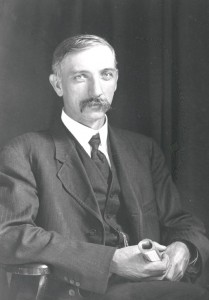Before A.B. Graham no one thought to teach children in rural communities in any organized fashion on how to be better farmers when they grew up. Because of Graham, though, the agricultural club system known as “4-H” was born, and has grown to include roughly 7 million young people in more than 50 countries.
Albert Belmont Graham was born on March 13, 1868, near Lena, Ohio. He attended school in a one-room schoolhouse; upon his graduation at the age of 17 he took over the teaching job. His father had died when Graham was young, and his mother supported her family as a seamstress. Graham’s grandmother, a Quaker, lent him money to attend the National Normal School, and after graduation in 1888 he enrolled in OSU. He stayed only one year, though, and returned to teaching. In 1900 he was elected superintendent of schools in Springfield, Ohio.
It was there, on January 15, 1902, that Graham founded the boys’ and girls’ agricultural club – the first of its kind in the United States and what would later become 4-H, which stands for Head, Heart, Hand and Health. The club was designed to supplement the education the children were receiving in school on the scientific study of agriculture.
 Youngsters were given seeds and taught how to test soil quality, how to plant and grow the seeds, to take notes and study scientific theory. They were asked to present their findings among their peers, and to conduct group projects. The club also worked with parents, helping to improve the quality of life in rural communities and to encourage good agricultural practices. The first club had 83 members who planted experimental plots of corn, vegetables and flowers, and kept meticulous records of their results.
Youngsters were given seeds and taught how to test soil quality, how to plant and grow the seeds, to take notes and study scientific theory. They were asked to present their findings among their peers, and to conduct group projects. The club also worked with parents, helping to improve the quality of life in rural communities and to encourage good agricultural practices. The first club had 83 members who planted experimental plots of corn, vegetables and flowers, and kept meticulous records of their results.
Meanwhile, Graham worked with OSU and the Ohio Agricultural Experiment Station at Wooster to test seed varieties and various agricultural methods. In 1905, OSU created the position of superintendent of agricultural extension for Graham, who by then was known statewide for his work with farming communities. The then-new service focused on what Graham had been doing all along: promoting healthy agricultural practices and encouraging schools to teach agriculture and home economics as part of their curriculum, as well as providing educational resources to students and the public.
Graham served as director at Ohio State until 1914, when he went to the New York State School of Agriculture to start a similar program there. Two years later, he moved to Washington, D.C., to work as chief of agricultural extension specialists for the U.S. Department of Agriculture. When he retired from that position in 1938, he returned to Columbus, staying active in the community and 4-H until his death on January 14, 1960, at the age of 91.
– Filed by C.N.






Recent Comments